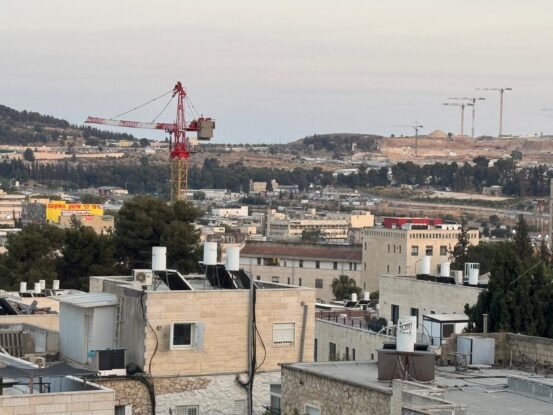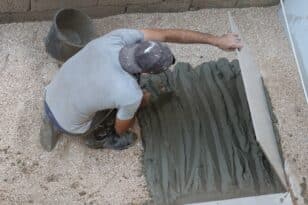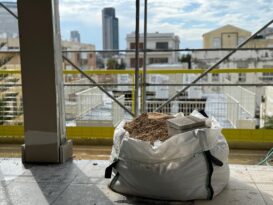According to the section on construction workers in Israel’s forthcoming 2024 Employment Report, government efforts—including the recruitment of foreign labor and incentives for Israelis entering the field—fell short of addressing the crisis caused by the war. The construction industry saw a sharp rise in job vacancies, widespread delays, and, at the peak of the crisis, nearly half of all construction sites were shut down—clear signs of a worsening construction labor shortage.
By Doron Breitman, Nadlan Center
It’s common knowledge that the Iron Swords War dealt a major blow to Israel’s construction industry, largely due to the halt in Palestinian workers entering sites within the Green Line. According to the section on construction workers in the 2024 Employment Report—an unpublished draft obtained by the Nadlan Center—“the cessation of Palestinian labor shocked the construction industry,” with the sharp rise in job vacancies throughout 2024 reflecting the severity of the construction labor shortage. By the end of the year, the report notes, the industry was still short approximately 28,000 workers.
The constructional labor shortage also caused significant building delays, with the number of completed projects dropping by about 16% compared to 2023. At the peak of the war, about half of all construction sites were inactive. Although that number decreased over the course of the year, in the last quarter of 2024, around 9% of sites were still stalled.
According to the report, at the beginning of 2024, the construction industry was short around 92,000 workers. The first solution to address this construction labor shortage was to bring in more foreign labor. Before the war, around 30,000 foreign workers were employed in construction. Following the outbreak of war, the government increased the quota so that foreign workers could replace Palestinian workers who could no longer enter. While the number of foreign constructon workers increased by approximately 33,000, it was nowhere near enough to solve the crisis.
Another solution promoted by the government was to incentivize Israeli workers to enter the construction industry by offering grants of up to NIS 29,000 for six months of work. However, the report reveals that by the end of 2024, only a few hundred workers received these grants, meaning the impact on the number of Israeli workers was minimal. “As a result of the grants, and likely due to other market incentives,” the report states, “there was an increase of about 20,000 Israeli workers in construction. The shortage narrowed during the year, but by year’s end, the industry was still missing around 28,000 workers.”
Jewish Workers Have Not Replaced Palestinan Workers
The severe construction labor shortage led to a significant rise in job vacancies, though not evenly across all roles. Openings for unskilled laborers and structural workers, for instance, more than doubled. However, the roles held by Jewish construction workers in 2024 closely mirrored those from the first three quarters of 2023, highlighting a consistent trend: Jewish workers tend to occupy more skilled or managerial positions and are far less likely to take on the manual labor roles typically filled by Palestinians. As a result, the overall occupational mix in the industry remained largely unchanged.
Arab Israeli workers, however, showed a different pattern. The number of Arab Israeli construction workers and their share in the industry increased, when looking at unskilled labor and finishing work, roles where their presence had previously declined. Meanwhile, their representation fell in areas that had seen growth in the past, such as management, structural work, and electrical work. According to the report, these shifts may reflect underlying professional gaps between Arab and Jewish workers, including disparities in education levels and wages.
The report also outlines the state of the industry prior to the war. In 2010, 221,000 people were employed in construction: 73% Israelis, 13% Palestinians, and 13% foreign workers. From 2010 until the war, the number of construction workers grew rapidly, reaching approximately 360,000 in the first three quarters of 2023. These figures represent an average annual growth of 3.5%, compared to an average growth of 2.5% per year in the broader labor market (including Israelis, foreign nationals, and Palestinians).
This growth was not evenly distributed across population groups. The number of foreign workers remained relatively stable throughout the period. While the number of Israeli construction workers did increase, it was at an annual rate of 2.5%—in line with the overall labor market, yet slower than the growth rate within the construction sector itself. As a result, Israelis (both Jews and Arabs) consistently accounted for about 5% of the total workforce in Israel. The primary driver of the construction sector’s rapid expansion was the sharp rise in Palestinian workers, whose numbers grew at an average annual rate of 8.9%.
The 2024 data suggests that while short-term measures helped ease some of the pressure, they were not enough to fully address the deeper, ongoing labor challenges in Israel’s construction sector. Without a more comprehensive approach, the construction labor shortage may continue to pose significant difficulties in the years ahead.

Nadlan Center is Israel’s leading real estate news and knowledge platform in Hebrew, created for industry professionals. Founded by experts in the field, it delivers in-depth, up-to-date coverage on urban renewal, planning and construction, taxation, and housing policy — tailored to the needs of developers, investors, planners, and financiers. In addition to its widely read news content, Nadlan Center hosts major industry events, professional conferences, and training programs that support the growth and development of the Israeli real estate sector.
Learn more: https://www.nadlancenter.co.il







